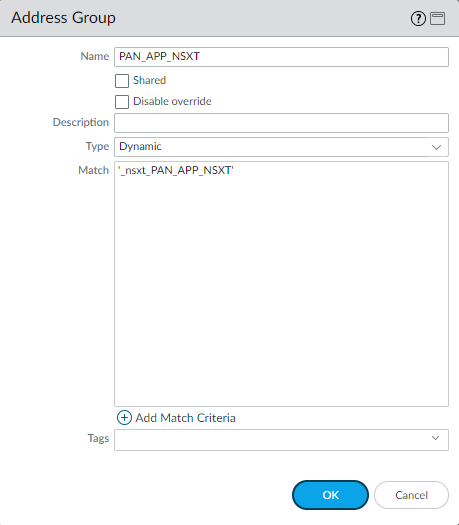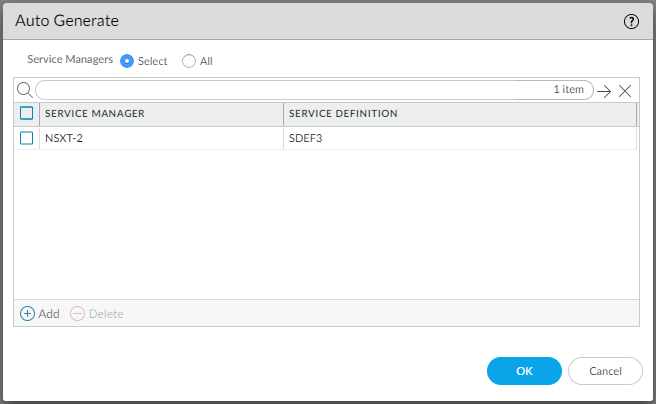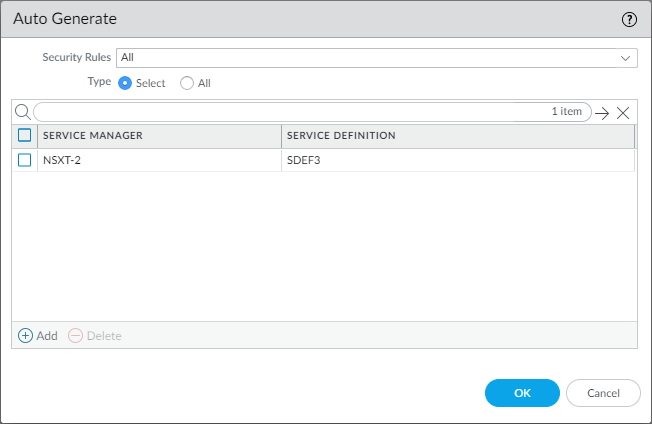Migrate from VM-Series on NSX-T Operation to Security Centric Deployment
Table of Contents
11.0 (EoL)
Expand all | Collapse all
-
- VM-Series Deployments
- VM-Series in High Availability
- IPv6 Support on Public Cloud
- Enable Jumbo Frames on the VM-Series Firewall
- Hypervisor Assigned MAC Addresses
- Custom PAN-OS Metrics Published for Monitoring
- Interface Used for Accessing External Services on the VM-Series Firewall
- PacketMMAP and DPDK Driver Support
- Enable NUMA Performance Optimization on the VM-Series
- Enable ZRAM on the VM-Series Firewall
-
- VM-Series Firewall Licensing
- Create a Support Account
- Serial Number and CPU ID Format for the VM-Series Firewall
- Use Panorama-Based Software Firewall License Management
-
- Maximum Limits Based on Tier and Memory
- Activate Credits
- Create a Deployment Profile
- Activate the Deployment Profile
- Manage a Deployment Profile
- Register the VM-Series Firewall (Software NGFW Credits)
- Provision Panorama
- Migrate Panorama to a Software NGFW License
- Transfer Credits
- Renew Your Software NGFW Credits
- Deactivate License (Software NGFW Credits)
- Delicense Ungracefully Terminated Firewalls
- Set the Number of Licensed vCPUs
- Customize Dataplane Cores
- Migrate a Firewall to a Flexible VM-Series License
-
- Generate Your OAuth Client Credentials
- Manage Deployment Profiles Using the Licensing API
- Create a Deployment Profile Using the Licensing API
- Update a Deployment Profile Using the Licensing API
- Get Serial Numbers Associated with an Authcode Using the API
- Deactivate a VM-Series Firewall Using the API
- What Happens When Licenses Expire?
-
- Supported Deployments on VMware vSphere Hypervisor (ESXi)
-
- Plan the Interfaces for the VM-Series for ESXi
- Provision the VM-Series Firewall on an ESXi Server
- Perform Initial Configuration on the VM-Series on ESXi
- Add Additional Disk Space to the VM-Series Firewall
- Use VMware Tools on the VM-Series Firewall on ESXi and vCloud Air
- Use vMotion to Move the VM-Series Firewall Between Hosts
- Use the VM-Series CLI to Swap the Management Interface on ESXi
-
-
- Supported Deployments of the VM-Series Firewall on VMware NSX-T (North-South)
- Components of the VM-Series Firewall on NSX-T (North-South)
-
- Install the Panorama Plugin for VMware NSX
- Enable Communication Between NSX-T Manager and Panorama
- Create Template Stacks and Device Groups on Panorama
- Configure the Service Definition on Panorama
- Deploy the VM-Series Firewall
- Direct Traffic to the VM-Series Firewall
- Apply Security Policy to the VM-Series Firewall on NSX-T
- Use vMotion to Move the VM-Series Firewall Between Hosts
- Extend Security Policy from NSX-V to NSX-T
-
- Components of the VM-Series Firewall on NSX-T (East-West)
- VM-Series Firewall on NSX-T (East-West) Integration
- Supported Deployments of the VM-Series Firewall on VMware NSX-T (East-West)
-
- Install the Panorama Plugin for VMware NSX
- Enable Communication Between NSX-T Manager and Panorama
- Create Template Stacks and Device Groups on Panorama
- Configure the Service Definition on Panorama
- Launch the VM-Series Firewall on NSX-T (East-West)
- Add a Service Chain
- Direct Traffic to the VM-Series Firewall
- Apply Security Policies to the VM-Series Firewall on NSX-T (East-West)
- Use vMotion to Move the VM-Series Firewall Between Hosts
-
- Install the Panorama Plugin for VMware NSX
- Enable Communication Between NSX-T Manager and Panorama
- Create Template Stacks and Device Groups on Panorama
- Configure the Service Definition on Panorama
- Launch the VM-Series Firewall on NSX-T (East-West)
- Create Dynamic Address Groups
- Create Dynamic Address Group Membership Criteria
- Generate Steering Policy
- Generate Steering Rules
- Delete a Service Definition from Panorama
- Migrate from VM-Series on NSX-T Operation to Security Centric Deployment
- Extend Security Policy from NSX-V to NSX-T
- Use In-Place Migration to Move Your VM-Series from NSX-V to NSX-T
-
-
- Deployments Supported on AWS
-
- Planning Worksheet for the VM-Series in the AWS VPC
- Launch the VM-Series Firewall on AWS
- Launch the VM-Series Firewall on AWS Outpost
- Create a Custom Amazon Machine Image (AMI)
- Encrypt EBS Volume for the VM-Series Firewall on AWS
- Use the VM-Series Firewall CLI to Swap the Management Interface
- Enable CloudWatch Monitoring on the VM-Series Firewall
- VM-Series Firewall Startup and Health Logs on AWS
- Simplified Onboarding of VM-Series Firewall on AWS
-
- Use AWS Secrets Manager to Store VM-Series Certificates
- AWS Shared VPC Monitoring
- Use Case: Secure the EC2 Instances in the AWS Cloud
- Use Case: Use Dynamic Address Groups to Secure New EC2 Instances within the VPC
-
- Intelligent Traffic Offload
- Software Cut-through Based Offload
-
- Deployments Supported on Azure
- Deploy the VM-Series Firewall from the Azure Marketplace (Solution Template)
- Deploy the VM-Series Firewall from the Azure China Marketplace (Solution Template)
- Deploy the VM-Series with the Azure Gateway Load Balancer
- Create a Custom VM-Series Image for Azure
- Deploy the VM-Series Firewall on Azure Stack
- Deploy the VM-Series Firewall on Azure Stack HCI
- Enable Azure Application Insights on the VM-Series Firewall
- Set up Active/Passive HA on Azure
- Use Azure Key Vault to Store VM-Series Certificates
- Use the ARM Template to Deploy the VM-Series Firewall
-
- About the VM-Series Firewall on Google Cloud Platform
- Supported Deployments on Google Cloud Platform
- Create a Custom VM-Series Firewall Image for Google Cloud Platform
- Prepare to Set Up VM-Series Firewalls on Google Public Cloud
-
- Deploy the VM-Series Firewall from Google Cloud Platform Marketplace
- Management Interface Swap for Google Cloud Platform Load Balancing
- Use the VM-Series Firewall CLI to Swap the Management Interface
- Enable Google Stackdriver Monitoring on the VM Series Firewall
- Enable VM Monitoring to Track VM Changes on Google Cloud Platform (GCP)
- Use Dynamic Address Groups to Secure Instances Within the VPC
- Use Custom Templates or the gcloud CLI to Deploy the VM-Series Firewall
-
- Prepare Your ACI Environment for Integration
-
-
- Create a Virtual Router and Security Zone
- Configure the Network Interfaces
- Configure a Static Default Route
- Create Address Objects for the EPGs
- Create Security Policy Rules
- Create a VLAN Pool and Domain
- Configure an Interface Policy for LLDP and LACP for East-West Traffic
- Establish the Connection Between the Firewall and ACI Fabric
- Create a VRF and Bridge Domain
- Create an L4-L7 Device
- Create a Policy-Based Redirect
- Create and Apply a Service Graph Template
-
- Create a VLAN Pool and External Routed Domain
- Configure an Interface Policy for LLDP and LACP for North-South Traffic
- Create an External Routed Network
- Configure Subnets to Advertise to the External Firewall
- Create an Outbound Contract
- Create an Inbound Web Contract
- Apply Outbound and Inbound Contracts to the EPGs
- Create a Virtual Router and Security Zone for North-South Traffic
- Configure the Network Interfaces
- Configure Route Redistribution and OSPF
- Configure NAT for External Connections
-
-
- Choose a Bootstrap Method
- VM-Series Firewall Bootstrap Workflow
- Bootstrap Package
- Bootstrap Configuration Files
- Generate the VM Auth Key on Panorama
- Create the bootstrap.xml File
- Prepare the Licenses for Bootstrapping
- Prepare the Bootstrap Package
- Bootstrap the VM-Series Firewall on AWS
- Bootstrap the VM-Series Firewall on Azure
- Bootstrap the VM-Series Firewall on Azure Stack HCI
- Bootstrap the VM-Series Firewall on Google Cloud Platform
- Verify Bootstrap Completion
- Bootstrap Errors
End-of-Life (EoL)
Migrate from VM-Series on NSX-T Operation to Security Centric Deployment
Use the following procedure to migrate your
operations-centric NSX-T deployment to a security-centric NSX-T
deployment.
- Log in to Panorama.Modify the match criteria of your dynamic address groups to follow the format required for a security-centric deployment.
- Select ObjectsAddress Groups.Verify that you are configuring the dynamic address groups in a device group associated with an NSX-T service definition.Click on the name of a previously created NSX-T dynamic address group.Edit the match criteria.For the dynamic address group to become a security group in NSX-T Manager, the match criteria string must be enclosed in single quotes with the prefix _nsxt_ followed by the exact name of the Address Group. For example, ‘_nsxt_PAN_APP_NSX’.Repeat this process for each security group you require.
![]() Set the security rules to be as NSX-T steering rules to intrazone.
Set the security rules to be as NSX-T steering rules to intrazone.- In Panorama, select PoliciesSecurityPre Rules.Verify that you are configuring the security rules in a device group associated with an NSX-T service definition.Click Add and enter a Name and Description for your security policy rule.Set the Rule Type to intrazone (Devices with PAN-OS 6.1 or later).In the Source tab, set the source zone to the zone from the template stack associated with the service definition. Then select a dynamic address group you created previously as the Source Address. Do not add any static address groups, IP ranges, or netmasks as a Source Address.In the Destination tab, Panorama does not allow you to set a destination zone because you set the rule type to intrazone. Then select a dynamic address group you created previously as the Destination Address. Do not add any static address groups, IP ranges, or netmasks as a Destination Address.Click OK.Repeat steps 1 through 7 for each steering rule you require.Commit your changes.Auto generate new steering policy.The following steps are for specifying service managers instead of selecting All.
- Select PanoramaVMwareNSX-TNetwork IntrospectionPolicy.Click Auto Generate.For Service Managers, choose Select.If you select All instead of selecting specific service managers, the plugin will generate steering policy for each service definition associated with each service manager in your configuration.Click Add to select the service manager.Select a Service Manager from the drop-down.Click Add to select the service definitions.Select the service definition from the drop-down.Click OK and click OK again.
![]() Commit your changes.Auto generate new steering rules.If you auto-generate steering policy, you must also auto-generate steering rules. And if you manually create steering policy, you must also manually create steering rules.The following steps are for specifying service managers instead of selecting All.
Commit your changes.Auto generate new steering rules.If you auto-generate steering policy, you must also auto-generate steering rules. And if you manually create steering policy, you must also manually create steering rules.The following steps are for specifying service managers instead of selecting All.- Select PanoramaVMwareNSX-TNetwork IntrospectionRule.Click Auto Generate.Select the type of Security Rules from the drop-down—All, Pre Rulebase only, or Post Rulebase only. The security rules are pulled from the service definitions specified in the following steps.For Type, choose Select.Click Add to specify the Service Manager(s) and Service Definition(s).Select a Service Manager from the drop-down.Click Add to select the service definition(s).Click OK.Click OK to finish or Add to specify additional service managers and service definitions.(Optional) Click on an auto-generated rule to modify the default options.
![]() Create Dynamic Address Group Membership Criteria.Commit your changes to Panorama.Delete the operations-centric steering rules from NSX-T Manager.
Create Dynamic Address Group Membership Criteria.Commit your changes to Panorama.Delete the operations-centric steering rules from NSX-T Manager.- Log in to NSX-T Manager.Select SecurityNetwork Introspection (E-W)Rules.Select each operations-centric steering rules.Click Delete.Delete the operations-centric service chain from NSX-T Manager.
- Log in to NSX-T Manager.Select SecurityNetwork Introspection SettingsService Chains.Click the vertical ellipses.Click Delete.
![]()




